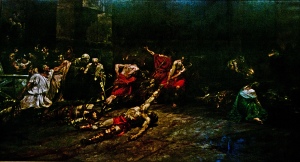Trek Shot
The painting is huge, seven meters wide by 4 meters high, it covers the whole wall of the foyer of the museum building. The painting is the Spoliarium by Filipino artist Juan Luna, it was a gold medalist in an exposition in Madrid , Spain when the Philippines was still a colony of Spain, the year was 1884. The museum building is the old congress, done in the 1920s and designed by American Architect Daniel Burnham.
This is one of two buildings that is the National Museum of the Philippines.
I’ve been planning this visit for quite sometime now, and with a friend I finally did it. The first building, the old congress building houses the art pieces, paintings, sculpture and other art works. On permanent display are the works of notable artists including Rizal who is shown to be an accomplished artist himself, a real genius. I have some comments on the set up though, the lighting do not show the paintings’ real beauty, glare and color cast of the incandescent bulbs and natural light filtering through the curtained windows interfere with the painting’s colors and hues. There are so many empty halls, I’m sure there are yet plenty of treasures in the museum’s store room worthy of being displayed and admired.
Taking photos inside the galleries are allowed but flash is not. I have to boost the ISO up and aperture wide to get handheld photos of those I liked to shoot. Ayala Museum do not allow cameras, this is a very good thing for visitors like me.
The second building is the old Finance building, and this building houses the artifacts collection including among others, the recovered treasures of the San Diego, a Spanish galleon that sunk in the waters of Batangas. On display were the defensive and offensive hardware of the galleons, and jars and chinese plates. The jars I teased my friend are akin to the amphorae of the Greek and Roman wrecks found in the waters of Mideterranean Sea. Those were used to carry Olive oil and wine. The jars found in the San Diego contained fermented fist paste, called bagoong (ha, ha). No gold and silver treasures were on display. The upper floors displayed the artifacts dug up from different regions of the archipelago, no gold yet were on display, just potteries and china. And yet more empty rooms. There were some dried leaves of plants, but are not native to the country, they were from South America, Australia and some other countries. I was hoping to find at least a dried sample specimen of the “gabi” plant, a native delicacy as cooked “laing”, there was none, maybe even this is not native to this place, Hawaiian maybe?
I had some fun interacting with some Tourism students who were there for their “OJT”, kind of apprenticeship they need to complete as a requirement of their course. I convinced them to act as if they were real Museum Guides and me and my friend as Museum Guests and Tourists on the country for the first time for a visit. We had great fun and I’m sure the girls enjoyed it too as I think they learned more from the questions we asked them.
We spent five hours including a lunch at the canteen which ran out of food as we came in. We have to wait for some food to be cooked for us but we didn’t mind, the whole experience is worthwhile, and a second visit is planned as I was not able to cover all that there is to see. I do hope that the people running this place will take more efforts to enrich the pieces on display so more people especially school kids to come and visit and see for themselves their Legacy.

